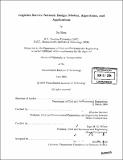| dc.contributor.advisor | Cynthia Barnhart and Nigel H.M. Wilson. | en_US |
| dc.contributor.author | Shen, Su, 1973- | en_US |
| dc.contributor.other | Massachusetts Institute of Technology. Dept. of Civil and Environmental Engineering. | en_US |
| dc.date.accessioned | 2005-10-14T20:28:31Z | |
| dc.date.available | 2005-10-14T20:28:31Z | |
| dc.date.copyright | 2004 | en_US |
| dc.date.issued | 2004 | en_US |
| dc.identifier.uri | http://hdl.handle.net/1721.1/29424 | |
| dc.description | Thesis (Ph. D.)--Massachusetts Institute of Technology, Dept. of Civil and Environmental Engineering, 2004. | en_US |
| dc.description | Includes bibliographical references (leaves 177-186). | en_US |
| dc.description.abstract | Service network design is critical to the profitability of express shipment carriers. In this thesis, we consider two challenging problems associated with designing networks for express shipment service. The first problem is to design an integrated network for premium and deferred services simultaneously. Related existing models adapted to this problem are intractable for realistic instances of this problem: computer memory requirements and solution times are excessive. We introduce a disaggregate information-enhanced column generation approach for this problem that reduces the number of variables to be considered in the integer program from hundreds of thousands to only thousands, allowing us to solve previously unsolvable problem instances. The second problem is to determine the express package service network design in its entirety, including aircraft routings, fleet assignments, and package flow routings, including hub assignments. Existing models applied to this problem have weak associated linear programming bounds and hence, fail to produce quality feasible solutions. For example, for a small network design problem instance it takes days to produce a feasible solution that is provably near- optimal using the best performing existing model. To overcome these tractability challenges, we introduce a new model, referred to as the gateway cover and flow formulation. Applying our new formulation to the same network design instance, it takes only minutes to find an optimal solution. | en_US |
| dc.description.abstract | (cont.) Applying our disaggregate information-enhanced column generation approach and gateway cover and flow formulation and solution approach to the network design problems of a large express package service provider, we demonstrate tens of millions of dollars in potential annual operating cost savings and reductions in the numbers of aircraft needed to perform the service. Moreover, we illustrate that, though designed for tactical planning, our new model and solution approach can provide insights for strategic decision-making, such as hub opening/closure, hub capacity expansion, and fleet composition and size. | en_US |
| dc.description.statementofresponsibility | by Su Shen. | en_US |
| dc.format.extent | 186 leaves | en_US |
| dc.format.extent | 5552658 bytes | |
| dc.format.extent | 5552467 bytes | |
| dc.format.mimetype | application/pdf | |
| dc.format.mimetype | application/pdf | |
| dc.language.iso | eng | en_US |
| dc.publisher | Massachusetts Institute of Technology | en_US |
| dc.rights | M.I.T. theses are protected by copyright. They may be viewed from this source for any purpose, but reproduction or distribution in any format is prohibited without written permission. See provided URL for inquiries about permission. | en_US |
| dc.rights.uri | http://dspace.mit.edu/handle/1721.1/7582 | |
| dc.subject | Civil and Environmental Engineering. | en_US |
| dc.title | Logistics service network design : models, algorithms, and applications | en_US |
| dc.type | Thesis | en_US |
| dc.description.degree | Ph.D. | en_US |
| dc.contributor.department | Massachusetts Institute of Technology. Department of Civil and Environmental Engineering | |
| dc.identifier.oclc | 56140245 | en_US |
